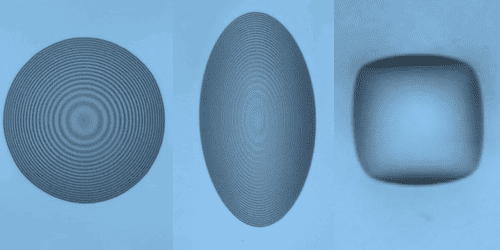
The shape of a liquid droplet can be controlled precisely by sandwiching it between two taut, elastic films. By varying the tension in the films, Rafael Schulman and Kari Dalnoki-Veress at McMaster University could create flat, elliptical, and almost square-shaped droplets. The experiment offers a relatively easy way to measure interfacial tension between liquids and elastic polymers and could also be used to create tuneable liquid lenses.
When a spherical liquid droplet comes into contact with a solid surface, the contact angle between the two substances can vary depending on a variety of properties, including the surface tension. The physics of this wetting process has been studied for over a century, but Schulman and Dalnoki-Veress realized that no-one had studied liquid droplets placed between two stretchable films.
To test how the contact angle affects droplet shapes in this situation, the duo designed a setup where glycerol and polyethylene glycol droplets were sandwiched between two elastic sheets, each stretchable in two orthogonal directions. Firstly, the researchers fixed one sheet to a hard surface and placed droplets of between 30-300𝜇m in diameter on top of it. They then stretched the second film equally in both directions, which caused the spherical droplets to flatten into pancake-like shapes.
Asymmetric stretching
The duo then repeated the experiment, this time stretching the top film more in one direction than the other, resulting in a surface tension that varied across the film. This time, the droplets took on elliptical shapes, with an aspect ratio that depended on the difference in tension between the two directions.
Next, the physicists detached the bottom sheet, and stretched both sheets equally in both directions. Remarkably, this caused the droplets to adopt square-like shapes, with their sides oriented along the directions of tension in the films.

Flash Physics: Droplets map out tension, sensitive robot skin, Cockcroft Institute spins out beam monitor
In the past, values for tension at the interface between liquids and elastic polymers have been notoriously difficult to calculate. However, from their observations, Schulman and Dalnoki-Veress saw that the easily-quantifiable variations in contact angles with tension allowed for relatively easy measurements of this value for the first time.
The duo also realized that the setup could be used to create liquid lenses with highly-tuneable aspect ratios. They also tested the lenses’ ability to focus light by passing a diffracted laser beam through them. This resulted in line-shaped spots for elliptical drops, while square droplets produced cross-shaped spot patterns.
The finding could provide useful insights for optics research in the future, and shows that further research into the already well-studied field of wetting could yet uncover new physical phenomena.
The research is described in Physical Review Letters.



